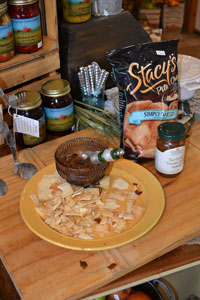7/30/2014
A Taste Sensation
Jennifer Polanz

Last month, we took a look at the power of the nose when it comes to retail. This month we dive into the gastronomical journey of taste, specifically samples. So let’s talk free stuff (which translates into more purchases).
Researchers at the University of Kentucky conducted a consumer survey in 2009 that showed farmer’s market shoppers are more interested in product samples than debit card acceptance or bathroom access at the market. In fact, it was the most important service they wanted to see at the market. Considering many retail garden centers either offer a farmer’s market, set up at a farmer’s market or at least offer some sort of food these days, this statistic is pretty telling.
Here’s another statistic that hits home: 63% of those consumers said they were either likely or very likely to try fresh fruit they’ve never tried before if they got a sample, while 55% said they were likely or very likely to try a fresh vegetable. More than half said they would try an unusual jam or jelly product, and nearly half said they’d try an unusual baked good. So if you want to expand your customers’ palettes with unique fruits, veggies or other food offerings, your best bet is to offer a taste.
The study also came up with some interesting finds when it comes to what prevents people from grabbing a sample. These are great points to know so you can combat them when it comes time to set up your sample table. For instance, a crowded sampling area scared off nearly 36% of respondents, while food safety concerns kept 26% away. Other concerns included the customers were uncertain of taste and uncertain ingredients. Food allergies kept 11% away, which could be alleviated with clear signage showing the ingredients in food products.
There were some key areas that factored into a customer trying a product, too. Friendliness of the vendor ranked No. 1, which means you can’t just sit samples out and hope people take them, eat them, like them and buy more. There’s a friendly sales pitch that has to take place, as well. Ease of accessing samples was the second highest reason for trying a sample and presentation of samples in the display ranked third.
Why Samples Work
So what’s the payoff for all this effort into offering samples? Based on the survey, 55% purchased products they hadn’t planned on based on the sample. Not only that, but 17% said while they didn’t buy it today, they would in the future. For 16%, the sample confirmed what they already knew: they would buy the product. Only 8% said they weren’t going to buy the product and the sample didn’t change their mind and 3% said the sample changed their mind to the negative—after trying, they didn’t buy it.
In a case study cited in the report “Best Practices for Sampling at Farmer’s Markets” compiled by the cooperative extension service at the University of Kentucky College of Agriculture, one market owner sets a specific time each week to invite vendors in to provide samples.
“We absolutely know that sampling sells products,” says Danielle Dove, marketing manager for Good Foods Market and Café in Lexington, Kentucky. “Our customers and owners love to sample new products and meet the folks who make them. Sampling Saturday is fun and a great way to showcase the local products we have.”
A Continued Customer
Samples also can help solidify loyalty to a particular vendor. Oftentimes, tasting the product goes a long way to not only purchasing once from that vendor, but several times. It also can result in word-of-mouth promotion, as enthusiastic samplers recommend the product and vendor to friends, according to the report. When asked if they would recommend the vendor to a friend, 74% said yes and 80% said they’d recommend the product to a friend. In addition, 59% said they would purchase other products from that vendor.
“From this data, sampling appears to accomplish the goals that vendors usually have for promoting repeat purchases,” the report states. “This goal of creating repeat purchasing also allows vendors to tell customers about their other products and the familiarity gained from a sampling experience is very important in creating these direct marketing relationships.”
GP